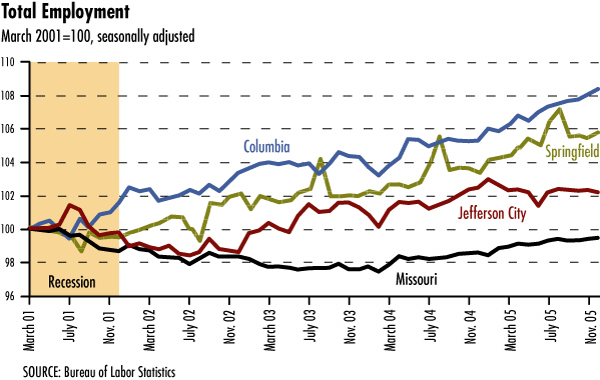District Overview: Three Metro Areas Outside St. Louis Outpace State of Missouri as a Whole
Jefferson City, Springfield and Columbia—the three metropolitan areas located in the St. Louis Zone of the Eighth Federal Reserve District, other than St. Louis—all saw their labor markets expand over the past five years in excess of what the state of Missouri as a whole experienced. All three metropolitan areas saw their employment decrease modestly during the national recession, which lasted from March 2001 to November 2001, then subsequently rise beyond pre-recession levels. As shown by the figure, employment as of December 2005 in Jefferson City, Springfield and Columbia stood, respectively, 2.2, 5.9 and 8.4 percent above their March 2001 levels, whereas the entire state remained 0.6 percent below its pre-recession level.
Jefferson City began experiencing steady employment gains toward the end of 2002, picking up roughly 2,600 jobs between January 2002 and December 2004. In 2005, however, the labor market cooled off somewhat, as total nonfarm employment fell by 0.7 percent or approximately 600 jobs. These recent losses were shared across both goods producers and service providers, although the former accounted for about two-thirds of the losses. In the case of the latter group, there were notable job gains last year within the broad sector of trade, transportation and utilities. However, these gains were more than offset by losses among other service providers, as well as in government employment.
Springfield demonstrated even stronger growth than Jefferson City over the past four years. Between January 2002 and December 2004, Springfield's employers added more than 6,000 jobs, a 3.6 percent gain. This upward trend continued last year, as payrolls rose by an additional 3,100 jobs. All of these job increases were due to Springfield's growing service industry. Employers in goods producing sectors continued to shed workers over the last year, losing roughly 600 employees in 2005.
Equally impressive has been the labor market performance of Columbia, which has seen its employment trend steadily upward since the end of 2001. In the three years ending in December 2004, Columbia's total employment rose by 2,400 or nearly 3 percent of its January 2002 level. Last year, the rate of job creation actually increased—total employment rose by 2.3 percent or 2,000 jobs. These gains were seen primarily in the service sector, including retail establishments, although smaller job gains were also registered by goods producers.
In spite of the impressive labor market gains in Jefferson City, Springfield and Columbia, the state of Missouri as a whole has continued to struggle to regain jobs lost during the recession. Even by the start of 2005, when the state's labor market had finally begun to show consistent growth, employment increased by only about 1 percent or roughly 27,000 jobs. By the end of last year, Missouri's employment remained more than 16,000 jobs below its pre-recession level. Analysts widely acknowledge job losses in manufacturing to be driving Missouri's job slump. Although goods producers recovered somewhat last year, adding nearly 9,000 jobs to their payrolls, employment in this sector remained more than 40,000 below its March 2001 level.
The industrial compositions of these three cities, which are not as heavily engaged in goods-production as the state as a whole, may explain why Jefferson City, Springfield and Columbia have outpaced Missouri in terms of employment during the past five years. For certain, the data reveal that Jefferson City, Springfield and Columbia are three bright spots amid a struggling Missouri labor market.
Views expressed in Regional Economist are not necessarily those of the St. Louis Fed or Federal Reserve System.
For the latest insights from our economists and other St. Louis Fed experts, visit On the Economy and subscribe.
Email Us


